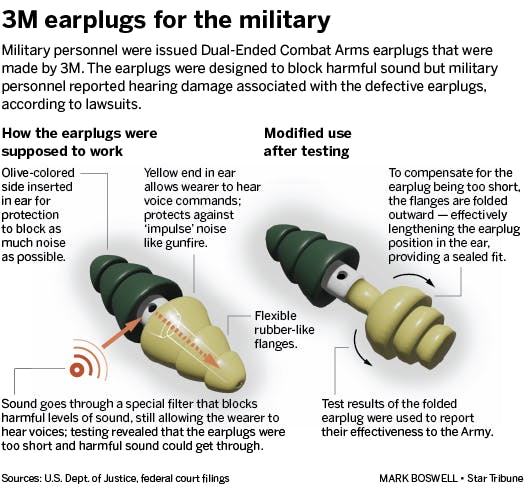The first trial in one of the largest U.S. mass torts ever kicks off Monday with 3M defending itself against claims that its Combat Arms earplugs were knowingly defective, harming the hearing of tens of thousands of soldiers.
3M became a giant in the military earplug market when it bought Aearo Technologies in 2008. The Maplewood-based company maintains that Combat Arms plugs were designed properly and worked as they should.
The size of the earplug litigation — nearly 230,000 claims are pending before a federal court in Pensacola, Fla. — dwarfs most mass torts. The case is being closely watched in legal circles.
"Anytime you get a case with this many people involved, people turn their heads," said Alexandra Lahav, a professor at the University of Connecticut School of Law. "It's an incredibly large number of complaints."
If the verdicts go badly for 3M, damages could tally in the hundreds of millions of dollars, if not more, based on the outcome of other large mass tort cases in recent years.


Judge M. Casey Rodgers of U.S. District Court for northern Florida will hear three consolidated claims in the first bellwether trial. It's expected to last through April. A bellwether trial is set for May and a third in June.
The plaintiffs in the first trial are Army veterans who claim hearing loss and tinnitus due to allegedly defective Combat Arms CAEv2 earplugs.
The CAEv2 plugs are the second version of Combat Arms, which were developed by Aearo and sold to the government from 1999 to 2015 when 3M abruptly discontinued the product.
The lawsuits are roped together in a "multidistrict litigation" or "MDL" case, which is used in the federal court system for complex product liability matters with many separate claims. MDL cases commonly feature bellwether trials, which set a tone for resolving all claims.
"The parties will use these cases as a way of gauging their arguments and the strength of their positions," said Henry Blair, a professor at Mitchell Hamline School of Law in St. Paul. "The bellwether is a way to gauge a settlement."
Lahav said that the more variance in bellwether trial outcomes, the more difficult for lawyers to forge a settlement. "You might see 10 to 15 trials before they are ready to settle." But ultimately, "they always settle around the bellwether."
As of March 15, there were 229,397 separate actions within the 3M earplug case, according to the U.S. Judicial Panel on Multidistrict Litigation. That makes it the largest MDL ever, according to Bloomberg Law.
The second largest involved 192,100 claims in an asbestos MDL. But actual asbestos product liability claims total around 750,000, including suits in state courts that weren't consolidated into an MDL, Lahav said.
In its 2020 annual report, 3M said it was defending 3,130 Combat Arms suits, including 14 putative class actions, that together involved 12,400 claims. The gap between those numbers and federal MDL data appears to be claims that have yet to served on 3M or completely vetted by the court.
"The vast majority of claimants that are being reported have not actually filed lawsuits and are solely part of an administrative docket," 3M said in a statement.
The earplug claims against 3M were lodged after the company settled a whistleblower suit in 2018.
That suit was brought by rival earplug maker Moldex-Metric on the U.S. government's behalf, after an inquiry by the Army Criminal Investigations Command. The suit claimed Aearo knew about "dangerous design defects" in 2000.
In a 2018 report, the Army concluded that had the government known about tests Aearo had done in 2000 it may not have purchased Combat Arms earplugs. In the whistleblower settlement, 3M paid a $9.1 million penalty, but denied all claims and did not admit liability.
At the heart of the MDL case is the U.S. Army's request in 1999 to Aearo to shorten the plugs so they would fit in a standard-issue military carrying case. The company did so, but plaintiffs claim Aearo's fix caused bigger problems.
Tests in 2000 at Aearo's Indianapolis laboratory indicated that the shorter earplug didn't always fit properly — and thus wasn't always effective — unless it was inserted in a particular way, according to internal Aearo documents filed in court.
3M claims it told the military about the fitting issues, and that the military was responsible for informing soldiers about the earplugs' proper fit.
Plaintiffs claim the earplugs leaked noise, damaging soldiers' hearing. 3M said in a statement that the "product was not defectively or negligently designed and did not cause injuries."
In July, Rodgers nixed a key legal strategy that 3M had planned to use: the "government contractor defense." It shields contractors from tort liability for defects in products designed and developed for the federal government.
3M has claimed that the Combat Arms CAEv2 was designed in close collaboration with the military.
But Rodgers ruled that the Army never issued a request for a design proposal for the earplug; and there was no contract between the Army and Aearo when a military representative told the company that the plugs needed to be shortened.
3M plans on calling three retired Army medical staffers to testify at the trial, two audiologists and a doctor who's an ear specialist.
All three can testify about deficiencies in the Army's hearing program that they observed or experienced. But Rodgers ruled that none of them can make any blanket conclusions about the program.
Mike Hughlett • 612-673-7003


![Capella Tower at 225 South Sixth St. Tuesday September 6, 2011. ] GLEN STUBBE * gstubbe@startribune.com Minneapolis skyline from the 51st floor of IDS](https://arc.stimg.co/startribunemedia/7C263DJZQTPRDEXI74SMH2M3HI.jpg?w=75&h=75&fit=crop&crop=faces)


